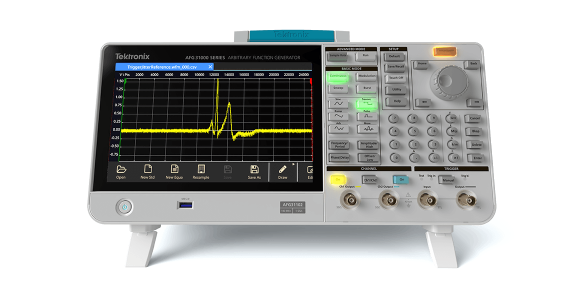
Contactez-nous
Chat en direct avec un représentant Tek. Service disponible de 9 h à 17 h, CET jours ouvrables.
Appelez-nous au
Disponible de 9 h à 17 h CET jours ouvrables.
Télécharger
Télécharger des manuels, des fiches techniques, des logiciels, etc. :
Feedback
Comparatif de générateurs de fonctions arbitraires
Les conceptions d'aujourd'hui sont souvent complexes et leur test requiert différents stimulus de signaux. Les générateurs de fonctions Tektronix sont les meilleurs instruments de leur catégorie et offrent une agilité de fréquence sans compromis, assurant une reproduction précise des signaux à chaque fois.
Avec les capacités des options de génération de signaux standard, de signaux arbitraires et de signaux avec défauts pré-chargées, les générateurs de fonctions Tektronix prennent en charge une large gamme d'applications et offrent une solution économique pour les applications ne nécessitant pas les capacités avancées d'un générateur de signaux arbitraires.
Trouvez le générateur de fonctions arbitraires adapté à votre application ou découvrez tous les générateurs de signaux Tektronix.
Également sur cette page
Comparer les générateurs de fonctions arbitraires Tektronix
| Comparer | Modèle | Voies analogiques | Fréquence d'échantillonnage | Bande passante | Résolution verticale | Longueur d'enregistrement | Gamme de fréquences de sortie | Prix de départ |
|---|---|---|---|---|---|---|---|---|
|
|
1 - 2 |
250 M éch./s à 2 G éch./s |
25 MHz à 250 MHz |
14 bits |
16 M éch./voie |
25 MHz à 250 MHz |
HKD 25,000
|
|
|
|
2 |
125 M éch./s à 300 M éch./s |
25 MHz à 60 MHz |
14 bits |
8 000 à 1 million de points |
25 MHz à 60 MHz |
HKD 7,970
|
|
|
|
1 |
250 M éch./s |
20 MHz |
14 bits |
128 000 points |
20 MHz |
HKD 18,200
|
Comparaison des séries du produit

|

|

|
|
| Générateur de fonctions arbitraires AFG31000 | Générateur de fonctions arbitraires AFG1000 | Générateur de Fonctions Arbitraires AFG2000 |
How to choose an arbitrary function generator
Though there are a number of factors to consider when choosing the right arbitrary function generator for your bench, here are a few of the most important considerations.
| Consideration | Description |
|---|---|
| Sample rate | This affects the frequency and fidelity of the main output signal. The sampling frequency must be more than twice that of the highest spectral frequency component of the generated signal to ensure accurate signal reproduction. |
| Bandwidth | The analog bandwidth of a signal generator’s output circuitry must be sufficient to handle the maximum frequency that its sample rate will support. In other words, there must be enough bandwidth to pass the highest frequencies and transition times that can be clocked out of the memory without degrading the signal characteristics. |
| Record length | This determines the maximum number of samples that can be stored and plays an important role in signal fidelity because it determines how many points of data can be stored to define a waveform. Particularly in the case of complex waveforms, memory depth is critical to reproducing signal details accurately. |
| Output frequency range | Perhaps one of the most important considerations—and often the biggest driver of price—is the frequency range. It’s essential to choose a function generator that can operate in a frequency range that supports your tests. |
| Noise and jitter | These two characteristics are very closely related and are essentially undesired distortions of the signal, which you want to keep as low as possible. |
| Number of channels | Depending on the application needs, a single output may be sufficient. But for IQ modulation for instance, two outputs are mandatory. |
| User interface | A large, modern touchscreen with responsive feedback has become a key factor in labs where test time is essential. |
Ressources
Frequently Asked Questions (FAQ)
What is a function generator used for?

A function generator is a piece of electronic test instrument used to generate and deliver standard waveforms, typically sine and square waves, to a device under test. It can be used to test a design or confirm that a piece of electronic equipment is working as intended.
What’s the difference between a function generator and a signal generator?
A signal generator is any device that creates electronic signals. A vector signal generator specializes in creating RF signals with analog and digital modulation schemes in formats such as QAM, QPSK, FSK, BPSK, and OFDM.
A function generator is a specialized piece of test equipment that has a preset list of waveforms or patterns that it can play. Function generators are known for their ability to rapidly switch from one frequency to another and are a more economical option than other more advanced waveform generators.
How do function generators work?

A function generator connects to a device under test (DUT) via test leads and creates voltage waveforms at a desired frequency to the DUT. Using the instrument’s front panel, the operator can change the parameters of a waveform, such as how fast it’s played, the amplitude and offset, or add basic distortion or modulation.
What is the difference between a function generator and an arbitrary waveform generator (AWG)?
A function generator primarily produces standard waveforms like sine, square, and triangle waves, while an arbitrary waveform generator (AWG) can create more complex and custom waveforms based on user input. AWGs are often used for advanced applications like high-speed signal testing.
What types of waveforms can a function generator produce?
Function generators can produce a wide range of waveforms, including sine waves for AC circuit testing, square waves for digital signal testing, triangle waves for waveform analysis, and arbitrary waveforms for custom signal generation.
Can I synchronize multiple function generators?
Yes, many function generators allow synchronization through various methods such as external triggers or synchronization inputs/outputs. This is particularly useful for generating complex waveforms or multi-channel setups.







